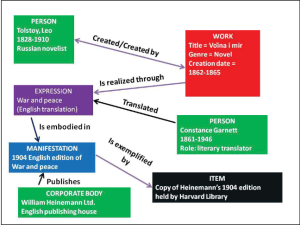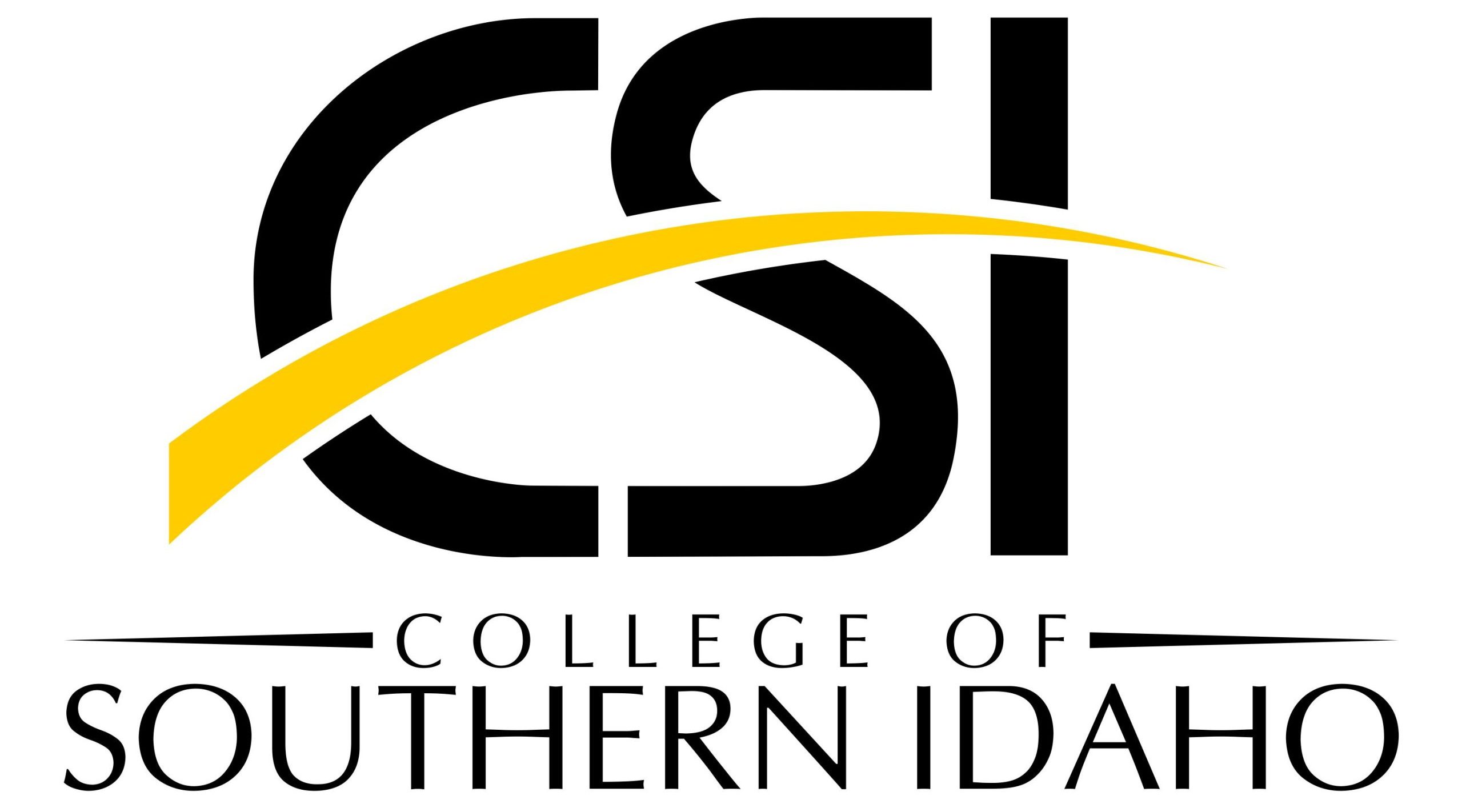3 FRBR, WEMI and their Impact on MARC
MARC records are not the only configuration for describing, categorizing, and classifying items. MARC 21 records have been influenced by Functional Requirements for Bibliographic Records (FRBR). This system is a theoretical one that categorizes and describes items according to their relationship to the information contained inside them.
It is important to understand the difference between various tools used or referred to in the cataloging community. FRBR is an ideology, a conceptual model. It is not tangible. There is no FRBR software. It simply guides how catalogers think about items, subjects, and people so that cataloging makes intuitive sense. RDA is a content standard. This regulates how certain metadata are expressed to ensure standardization. MARC, on the other hand, is the format in which most cataloging records are generated. MARC uses RDA to express metadata in a way that aligns with FRBR. The relationships between these three items, and the fact that they are not the same type of tool, are important to know before you begin to work with them.
MARC and RDA possess information about the physical characteristics, author, title, and number of pages of a particular item. FRBR describes the items by exploring their relationships, typically using the original iteration of its information as provided by the author. This information is combined with the other metadata provided by MARC and RDA to give a thorough, complex description of each item in the library’s holdings. Additionally, the relationship between one item and the others in the library’s holdings is also made manifest. In order to complete this, catalogers use a system called WEMI.
WEMI Hierarchy
There are four main steps in the entity hierarchy of WEMI:
- Work: A work is the broadest level of the hierarchy. It is the original iteration of an idea created by an author. For example, Second Foundation in The Foundation trilogy was published by Isaac Asimov in 1952. While there was a first edition of the book, that first edition is not the work. Instead, the words and ideas within that edition constitute the work. A work is represented by a title and an author. Works can be related to each other if one is derived from the other. Some of the fields of the MARC record that deal with the Work hierarchy are 100, 130, 240, 245, and 380.
- Expression: The level below a work is an expression. This is a particular format in which the work has been presented. For example, a play based on Second Foundation would be a different expression than the text version in the book. Alternate translations of the work may also be considered discrete expressions. A sign of this is the fact that many library systems have different call numbers for different translations of the same work. For example, the CSI Library has a different LOC call number for works in Spanish than for those in English. For example, Harry Potter and the Sorcerer’s Stone, the American manifestation of Harry Potter and the Philosopher’s Stone, has a LOC call number at the CSI Library of FIC .R69 H371 1998. The Spanish translation, Harry Potter y la piedra filosofal, has a call number of SPA FIC .R69 H371 2001. Some of the Expression-level MARC fields include 130, 240, 255, 336, 507, 520, and 546.
- Manifestation: Yet another level in this system is the manifestation. This is often confused for an item, but these two things are not the same. An edition may be considered a manifestation of a particular expression. Multiple items of the same edition can all be considered individual parts of a particular manifestation. For example, if a library buys two copies of the same edition of a book due to high circulation, these may be considered to be iterations of the same manifestation. If, on the other hand, they are different editions, then they are different manifestations. There are many manifestation-level MARC fields, including 245, 250, 264, 300, 319, 337, 338, 347, 490, 500, and 856.
- Item: The item is the individual copy of a book. Each item has its own MARC and FRBR record. An item is represented by a call number, whether that number is part of the Library of Congress Classification System or the Dewey Decimal System. Item-specific parts of the MARC record include the item identifier, which can be included in multiple fields, and fields in the 5XX range which are related to restrictions.
Trinity of FRBR
There are three elements in the FRBR system. The parts of the WEMI hierarchy are called entities. Specifically, these are called Group 1 entities. Group 2 entities are people and organizations or corporate bodies. Group 3 entities are the subjects that can be discussed by works. Group 1 and Group 2 entities can be Group 3 entities if there are works written about them. Group 2 entities are described by multiple MARC fields in different contexts. Individuals can be described by MARC fields 100, multiple fields in the 37X range, 670, and 700. Families are described by 100, 376, and 670. Corporate organizations are described by 110, 111, 368, 370, and 670.
The second aspect of FRBR is the relationship between multiple entities. For example, in the sentence “William Shakespeare wrote a play about Macbeth,” the phrase “wrote a play” is the relationship.
The third relationship in the FRBR triangle is the attributes of the item. This is where the rest of the MARC or RDA record comes in. The metadata regarding editions, text font, page numbers, subjects, and authors are all considered attributes of an item. Relationships between an item and its author can also form connections between other works created by that author. Attributes function as a way to build less direct connections and imply relationships. On the front page recto (front side) of the item are usually the title, author, and publisher. On the verso, or back side, are also the title, author, and publisher information. Additionally, subject, publication information, language, and many other attributes are listed.
Content relationships
The major relationship regarding works in the above trifecta is those regarding works and their subjects. Content relationships explain how works are related to each other. Some are different manifestations or expressions of the same work. The information in two items that are the same work are essentially the same, barring any information lost by versioning, translation, or the creation of a new edition. These items may be said to be equivalent.
Some are derivations of other works. Therefore, the information in the derivation is only part of the information in the original work. New information may be added to this derivation. Examples of derivations include dramatizations, subtle changes to the themes, perspective changes, and other modifications.
Another relationship occurs when one work is descriptive of another work. These include commentaries, annotated and edited anthologies, and reviews. The information in the original work is analyzed and may or may not be fully dealt with in the descriptive work.
User Tasks
One may ask, “other than facilitating cataloger understanding of the need for schemata like MARC and RDA, what does FRBR do?” This system actually does more for users than may be immediately apparent. It facilitates five actions that all users perform when they engage with items. These user actions replace the three “Objects of Catalogs” that Charles Ammi Cutter, one of the major pioneers of cataloging, theorized. According to him, there were three major finding goals of users that a catalog should facilitate: finding a specific book, finding groups of books by author, subject, or genre, and finding a book that specifically suits their needs. FRBR expanded upon these functions to create their new “user tasks.”
- Find: A user encounters multiple possible answers to a query through examining the attributes and relationships of works. To facilitate this task the information system needs to support searching by offering appropriate search elements or functionality.
- Identify: If a user is looking for specific attributes and/or relationships, they can locate the exact copy or manifestation they are looking for. If they are looking for a wider range of possible answers to their query, they can also identify any item of several that fulfills their needs. To facilitate this task the information system seeks to clearly describe the resources it covers. The description should be recognizable to the user and easily interpreted.
- Select: A user can view or examine only those items that fulfill their criteria. To facilitate this task the information system needs to allow/support relevance judgments by providing sufficient appropriate information about the resources found to allow the user to make this determination.
- Obtain: As long as restrictions allow, a user can obtain the item, or access to it or a version of it, through the machinations facilitated by the catalog. To fulfill this task the information system needs to either provide direct links to online information or location information for physical resources. It also needs to give any instructions required to complete the transaction or any restrictions on access.
- Explore: The explore task is the most open-ended of the user tasks. The user may be browsing, relating one resource to another, making unexpected connections, or getting familiar with the information resources available for future use. The explore task acknowledges the importance of serendipity in information seeking. To facilitate this task the information system seeks to support discovery by making relationships explicit and by providing contextual information and navigation functionality.
If these ideas seem difficult to understand, you are not the only one confused by this. View this diagram of the relationship between the English translation of War and Peace and its translator, the author, and the original work, which was written in Russian.

In order to fully explore and delineate the relationships and attributes of entities to fulfill user tasks, some have stated that a new way of recording metadata must be made. For this reason, the Resource Description Framework (RDF) was invented. This was also partially a response to the need for controlled vocabulary. For more information about this framework and changes in schemata, visit Appendix B.
For a much more thorough and complex, yet understandable, explanation of this system read the FRBR Library Resource Model document created by the International Federation of Library Associations and Institutions. Another simple resource was created by Dr. Pamela Thomas of the Illinois Heartland Library System.
This chapter is a remix of several works, including:
FRBR and RDA: What they are and how they may affect the future of libraries by C.R. Croissant. This work is licensed with a Creative Commons Non-Commercial 4.0 International License.
FRBR-Library Reference Model, by Pat Riva, Patrick Le Boeuf, and Maja Zumer, licensed with a Creative Commons Attribution License.
A theoretical system that ensures that an item is described as accurately and thoroughly as possible. The two major constructs in FRBR are WEMI and the RDA framework.


Feedback/Errata